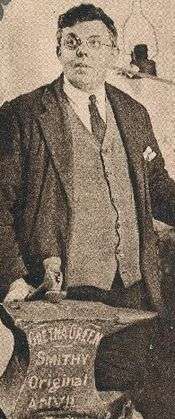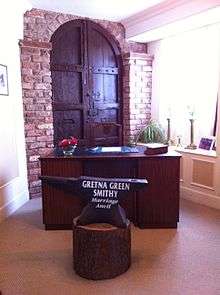Richard Rennison
Richard Rennison (29 October 1889 – 5 August 1969) was the last "anvil priest" at Gretna Green, Scotland. Between 1926 and 1940, he performed "irregular marriages" of couples over the anvil at the Old Blacksmith Shop, where the couple proclaimed that they were single and wanted to get married in front of witnesses. As "anvil priest", Rennison generally requested a fee of £1, but was known to earn up to £20 for a ceremony (approximately £3,030 in 2012).
Richard Rennison | |
|---|---|
 Image of Richard Rennison in 1933, standing above the marriage anvil. | |
| Born | 29 October 1889 Shankhouse, Northumberland, UK |
| Died | 5 August 1969 (aged 79) Haltwhistle, Northumberland, UK |
| Known for | Last "anvil priest" |
The popularity of the marriages grew whilst he was performing them, to the point that a special committee was formed to look at marriage in Scotland, to which Rennison was called as a witness. By the time "irregular marriages" were outlawed in Scotland by the Marriage (Scotland) Act 1939, Rennison had conducted 5,147 ceremonies.
Personal life
Richard Rennison was born on 29 October 1889 in Shankhouse, Northumberland to coalminer James Rennison and his wife Ann. He spent time working as a "General Dealer" and as a photographer.[1] He also spent time as a Methodist preacher in Tyneside.[2] In 1923, he married Jessie Little in Nicholforest, Cumberland. The pair moved to Gretna in 1926, by which time Rennison was describing himself as a saddler, an ironmonger and a boot maker.[3] When he moved to Gretna, he initially set himself up as a saddler and opened a cafe, before being taken on by Hugh Mackie, the manager of the Old Blacksmith's Shop.[3] Rennison died on 5 August 1969 at Haltwhistle, Northumberland.
The last "anvil priest"

Before 1940, marriage in Scotland was based on Celtic customs, rather than Catholic religious customs. As such, marriage only required a couple to agree to be married in front of witnesses. The simplicity of these "irregular marriages" meant that they were used by couples who wished to elope, and Gretna Green became a hotspot for elopement because it was the village in Scotland nearest to the English border. The marriages were provided by the blacksmith as he was certain to be a citizen of Scotland and was easy to find at the forge.[4]
Hugh Mackie purchased the Old Blacksmith's Shop at Gretna Green in 1890 and resided there as "anvil priest" until 1926 when he was looking to retire and find a replacement. Mackie found Richard Rennison, who had recently joined the community, and by October 1927, Rennison was presiding over marriages and acting as caretaker of the shop.[5] The shop had ceased any metalwork in 1900 and was solely used for marriage ceremonies.[1] A natural showman, Rennison soon became the resident "anvil priest" and set about marrying people. He would regularly point out that, although he was not a member of the clergy, he could marry people as he was "No Sinner" – the reverse of his surname![4] In his first ten years, he married around 2000 couples,[1] the majority of whom were couples between 40 and 60 years old.[6] By 1939, the number of marriages he had performed had increased past 4000 due to the many young men who wanted to get married before starting their service in World War II.[7]
| Year | Number of marriages[3] |
|---|---|
| 1926 to 1928 | 365 |
| 1929 | 304 |
| 1930 | 331 |
| 1931 | 244 |
| 1932 | 215 |
| 1933 | 210 |
| 1934 | 321 |
| 1935 | 305 |
Marriages at the blacksmith shop were inconsistent during Rennison's time as "anvil priest". Although they followed the same pattern, and both parties were to declare in front of witnesses they were single and that one had lived in Scotland for 21 days,[1] there are documented cases where these requirements were not confirmed.[8] At this point, Rennison would strike the hammer on the anvil, and the couple would be married. Rennison's wife often acted as a witness to the couples getting married, and sometimes performed the ceremonies herself.[9] The marriage fee was supposedly £1, but Rennison would sometimes perform the ceremony for free or however much he was given; in one case he received £20 (worth approximately £3,030 in 2012).[note 1][3] If witnesses were required, they would be provided at the cost of 2s 6d each.[note 2]
Rennison travelled to London in 1931 for a "sight-seeing visit", and he brought the anvil with him to protect it from theft. The anvil never left his side, despite weighing 240 pounds (110 kg).[10] The Leader-Post suggested that, since the cost of a new anvil was much less than the cost of transporting the old one, this was more likely to be a publicity stunt.[11]
In 1935, due to the increasing popularity of the Gretna Green "irregular marriages", a special committee headed by Lord Morison was appointed to look at marriage in Scotland.[12] Rennison gave evidence before the committee in 1936.[3] There he claimed that he was known as "the Gretna priest", but did not dress like one and stated that he knew he was not one.[1] He also confirmed that he had been removing the word "priest" from marriage certificates and telling couples that they needed to confirm their marriage with the registrar at Dumfries.[3] The committee's findings led to the Marriage (Scotland) Act 1939, which outlawed the process of "irregular marriages". When the new law came into force in 1940, Rennison had performed 5,147 marriages.[4][13] His role then changed to a symbolic one, "blessing" marriages and acting as caretaker of the forge. He also regularly appeared at court to ensure the marriages he performed were judicially recognised.[14]
Notes
- Comparing average earnings between 1930 and 2012, £1 is valued at approximately £152 by MeasuringWorth.com and £20 is valued at approximately £3,030.
- Comparing average earnings between 1930 and 2012, 2s 6d is valued at approximately £19.70 by MeasuringWorth.com.
References
- "Many Marriages at Gretna Green". The Calgary Daily Herald. 2 June 1932. Retrieved 22 August 2012.
- Cummings, A. C. (31 March 1934). "Airdrome at Gretna Green to speed up runaway weddings". Ottawa Citizen. Retrieved 8 November 2012.
- "Gretna Marriages Blacksmith 'Priest' A Photographer". The Times. 8 March 1936.
- Sinclair, Olga (1989). Gretna Green : a romantic history. London: Unwin Hyman. p. 112. ISBN 0044403283.
- House of Commons bill (1936). Papers by command, Volume 13. Her Majesty's Stationery Office.
- "No Loopholes". Evening Post. 23 January 1937. Retrieved 8 November 2012.
- "People in the news". The Bulletin. 29 December 1939. Retrieved 22 August 2012.
- "High Court Of Justice Chancery Division A Marriage Ceremony At Gretna Green Invalid, Sefton-Toms v. Stirling". The Times. 29 March 1930.
- "Blacksmith wife welds marriages on Gretna anvil". Free Lance-Star. 7 May 1929. Retrieved 8 November 2012.
- "Gretna 'Marrier' totes his anvil". The Vancouver Sun. 23 February 1931. Retrieved 8 November 2012.
- "The Marrying Smith". Leader-Post. 16 March 1931. Retrieved 8 November 2012.
- "Gretna Green Anvil service defended". Ellesmere Guardian. 8 November 1935. Retrieved 8 November 2012.
- Burke, Gerry (5 October 1978). "Couple beat 47-year hitch". The Glasgow Herald. Retrieved 22 August 2012.
- "Niceties of the law". The Glasgow Herald. 13 July 1963. Retrieved 22 August 2012.